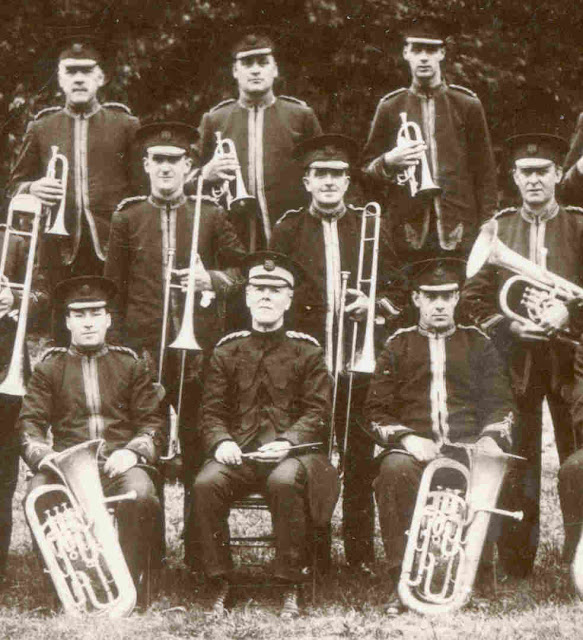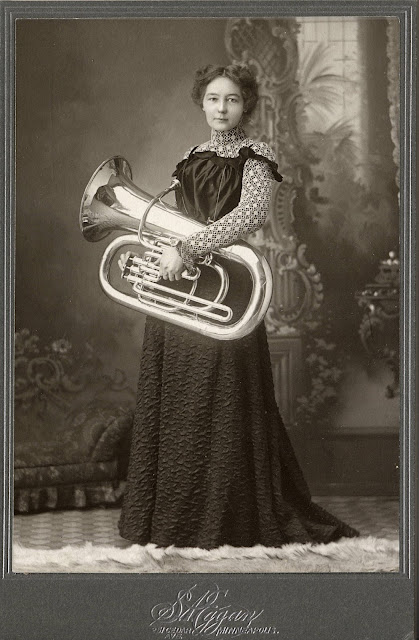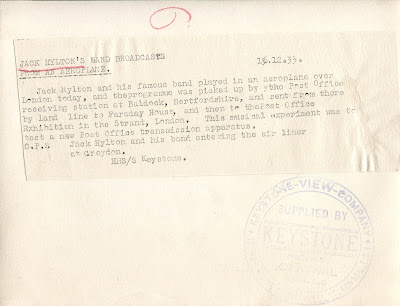Win the gold medal.
Take a first place.
Bring home the silver cup.
All prizes of competitions
but not always just in sports.
Musical pursuits can also reward
players for excellence.
The accolades are rewards for achievements,
for teamwork, and superior performance.
And the value is priceless as a prize
measures a superlative
that needs no qualification.
For in that moment they were the best.
This is a story about two postcards of prize bands,
one famous and the other forgotten.
But both representative of a great musical tradition—
the British brass band.
The Spencer's Steel Works Band was a band made up of largely working-class men from Newburn, England, most employed at the steel mill there. It began as the Walbottle Temperance Band in about 1894 and in 1897 was reorganized with sponsorship from the Newburn steel works. During the last part of the 19th century Britain enjoyed a phenomenal surge in amateur music with countless community choirs, orchestras, and bands. Supposedly in 1896 there were 40,000 brass bands listed in the census for the United Kingdom, but this number likely included groups from churches, schools, the Salvation Army, and the military too. In any case the number of brass bands like the Spencer's Steel Works Band was certainly beyond 14,000 during the height of brass popularity.
Many or the bands were connected to industrial centers like mining, manufacturing, but quite a few were started as part of the Temperance and Christian movements. The Spencer's Steel Works band followed the traditional brass band model of instrumentation with piston valve cornets, altohorns, tenorhorns, euphoniums, slide trombones and tubas in various keys and accompanied by a couple of drummers. The 30 players are led, I believe, by the gentleman in the bowler hat standing to the left of a large prize cup won by the band in a music contest against other brass bands.
The postcard was sent to a Mr. Bell of Brixton Hill in London. The postmark is not entirely clear but I think it reads June 24, 1907 or 09.
Hope this will find
you well. I have been
wanting to send you
this photo of our band,
but could not get to
know of your address
before now. M–d sends
her love, & she saids she
owes a letter to you I will
remind her of it. Sorry cannot
find time to call on you this
time. Kind regards to Mrs. B–
Yours Faithfully
xo. Roy'ant (?)
you well. I have been
wanting to send you
this photo of our band,
but could not get to
know of your address
before now. M–d sends
her love, & she saids she
owes a letter to you I will
remind her of it. Sorry cannot
find time to call on you this
time. Kind regards to Mrs. B–
Yours Faithfully
xo. Roy'ant (?)
Spencer's Steel Works was a large steel mill built at Newburn, England on the banks of the River Tyne, near the great industrial city of Newcastle upon Tyne. Established by john Spencer in 1822. At its height the mill employed 1,500 workers making steel plates, springs, and other parts for countless railway, shipping, armaments and mining industries around the world. In the early 1900s the mill's surplus steam also powered generators for the Newburn electric power station. Following the end of WW1 when demand for steel declined, the Spencer Steel Works closed in 1926 and the mill site was demolished in 1933.
 |
| Spencer's Steel Works, Newburn c.1920 Source: Newcastle Libraries |
British newspapers regularly reported on brass band contests like this one in December 1907 when the Spencer's Steel Works band played at a contest in South Shields. There were ten bands, one from an iron works, two from coal mines, a few from temperance and Christian societies, and the Spencer band which won first place, a cup, and £15. If I am correct about the postcard date, the band would need a larger table to display it's prizes.
According to the website BrassBandResults.co.uk , an encyclopedic compendium of every statistic on every brass band anywhere at anytime in history, the Spencer Steel Works Prize Band entered its first concert in May 1897 at Hartwistle in Northumberland and competed in 81 contests until its last one in Newcastle in November 1925 after which it was disbanded.
The second image comes from a postcard that was never posted but dates from the first decade of the 20th century. This band had no need to display it's prizes as it had already earned fame from it's many contest wins. It is the Besses o' th' Barn Band the oldest brass band in the world having performed continuously since it was established in 1818.
Originally a mixed ensemble of brass and woodwind instruments, in 1853 it became strictly an all-brass band (with drums of course). It takes its name from the Besses o' th' Barn suburb of Whitefield, Greater Manchester where the band maintains its own a rehearsal building. The 22 musicians here are arranged in an orderly way around their director who is seated center. Almost all the British brass bands in this era wore a quasi-military uniform with more refined decorative embroidery than bands in America or other European nations. Like the Spencer band there are only brass instrument and no woodwinds.
Early on in the mid-19th century the members of the Besses Band achieved enough success to establish the band as a limited company in 1897. This business arrangement made the Besses into a professional ensemble with the ability to provide musicians benefits as well as publish their own music and engage composers to write new scores for brass band. With such a long heritage it is no surprise that the Besses o' th' Barn Band competed in many contests, over 708 according to BrassBandResults. Beginning in 1821 with a band contest at the coronation of King Geroge IV where it took 1st prize, followed by another first in 1837 at Queen Victoria's coronation, until as recently as February 2022 when it placed 12th.
When this postcard was printed the Besses were at the height of popularity and used their celebrity to make a few world tours of the British empire in the early 1900s, traveling to Australia, Canada, Fiji, Hawaii, New Zealand, South Africa as well as the United States. In 1932 the band played 112 concerts during a tour of Canada between August and October. More of their history can be found at their website, www.Besses.co.uk.
The Besses o' th' Barn Band have their own YouTube channel where they have a great selection of the band's many recordings that are edited for video. Several date back to the very early years of sound recordings so here is the appropriately titled, 20th Century March, composed by James Ord Hume (aka William German) and recorded to a 78rpm disc by the Besses o’ th’ Barn Band in 1904. The video includes several more postcard images of the band.
* * *
* * *
We can get a sense of what the contests were like
in this short newsreel from British Pathé
entitled, National Band Contest (1935).
in this short newsreel from British Pathé
entitled, National Band Contest (1935).
It's interesting that during the entire day
the judges of the contest were secluded
inside a small closed tent next to the bandstand,
guarded by a policeman, and hidden from the bands
so that their decision would be unbiased
and based only on what they heard of each performance.
* * *
* * *
Many years ago when I lived in London I studied with the horn soloist, Ifor James, who for a time was a director and performer in the Besses o' th' Barn Band. Though my concentration was more on the orchestral horn repertoire I did gain from him an insight into the British brass band traditions and the brilliant technique that infuses the sound of Britain's many virtuoso brass instrumentalists. The musical continuity of Ifor James' band heritage and its performance style is something I am proud to have earned a connection to, even if a very small one. It's a prize to treasure.
This is my contribution to Sepia Saturday
where a prize photo is always a winner.
where a prize photo is always a winner.





































